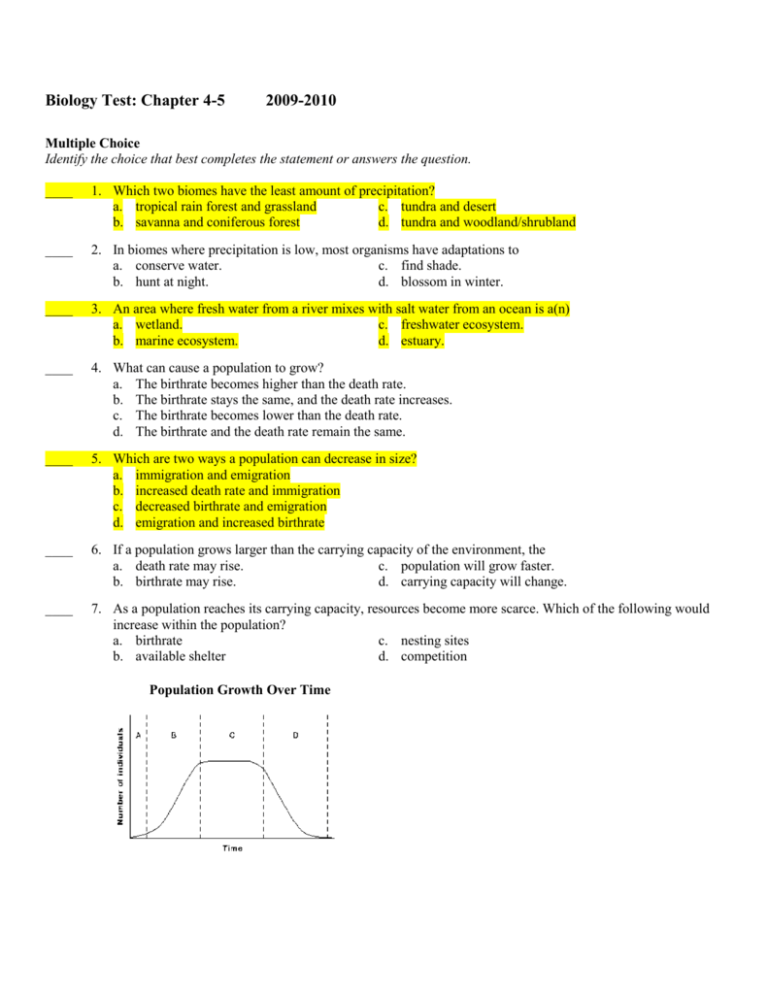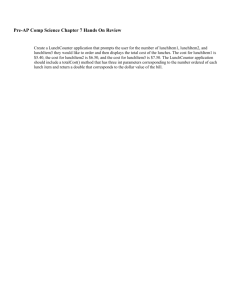Test 3 Chapter 4 and 5 - Kenton County Schools
advertisement

Biology Test: Chapter 4-5 2009-2010 Multiple Choice Identify the choice that best completes the statement or answers the question. ____ 1. Which two biomes have the least amount of precipitation? a. tropical rain forest and grassland c. tundra and desert b. savanna and coniferous forest d. tundra and woodland/shrubland ____ 2. In biomes where precipitation is low, most organisms have adaptations to a. conserve water. c. find shade. b. hunt at night. d. blossom in winter. ____ 3. An area where fresh water from a river mixes with salt water from an ocean is a(n) a. wetland. c. freshwater ecosystem. b. marine ecosystem. d. estuary. ____ 4. What can cause a population to grow? a. The birthrate becomes higher than the death rate. b. The birthrate stays the same, and the death rate increases. c. The birthrate becomes lower than the death rate. d. The birthrate and the death rate remain the same. ____ 5. Which are two ways a population can decrease in size? a. immigration and emigration b. increased death rate and immigration c. decreased birthrate and emigration d. emigration and increased birthrate ____ 6. If a population grows larger than the carrying capacity of the environment, the a. death rate may rise. c. population will grow faster. b. birthrate may rise. d. carrying capacity will change. ____ 7. As a population reaches its carrying capacity, resources become more scarce. Which of the following would increase within the population? a. birthrate c. nesting sites b. available shelter d. competition Population Growth Over Time ____ 8. Refer to the illustration above. Which time period shows exponential growth of the population? a. period A c. period C b. period B d. period D ____ 9. Refer to the illustration above. During which time period will the growth rate of the population be zero? a. period A c. period C b. period B d. period D ____ 10. The human population began to grow exponentially during the middle of the 1700s due to the a. development of agriculture. c. Industrial Revolution. b. increased immigration. d. decline of the Ice Age. ____ 11. Young adult male chimpanzees look for mates outside their own population. The males then take the females back to their group. Which of the following occurs in females’ original population? a. emigration c. mortality b. immigration d. natality ____ 12. Density-independent factors that limit population growth include a. parasites. c. disease. b. temperature. d. competition. ____ 13. The factors that tend to reduce the size of a population regardless of its initial size are a. density-dependent factors. c. ecological factors. b. density-independent factors. d. biotic factors. ____ 14. A J-shaped population growth curve becomes an S-shaped one a. as more resources become available. b. if the data are plotted on semi-log graph paper. c. as the carrying capacity is reached. d. if reproduction stops. ____ 15. The biome with the greatest range of daily temperature extremes is the a. tundra. c. tropical rain forest. b. taiga. d. desert. ____ 16. The biome most in danger of desertification is the a. desert. c. deciduous forest. b. grassland. d. tropical rain forest. ____ 17. In dry shrublands and woodlands a. plants are adapted to episodes of fire. b. primary production is abundant throughout the year. c. there are constant cool temperatures throughout the year. d. winters are mild and summers are wet. ____ 18. The biome with the greatest amount of topsoil and the richest, most fertile soil is the a. tundra. c. tropical rain forest. b. grassland d. taiga ____ 19. A biome with grasses as primary producers and scattered trees adapted to prolonged dry spells is a a. woodland and shrubland. c. tundra. b. savanna. d. taiga. ____ 20. Which biome is characterized by plants whose leaves turn color and drop off in the autumn? a. coniferous forest c. deciduous forest b. tundra d. tropical rain forest ____ 21. Freshwater lakes in temperate regions will turn over in the a. fall. d. summer. b. winter. e. fall and spring. c. spring. ____ 22. The open sunlit water in a lake with its suspended phytoplankton is the ____ zone. a. epipelagic c. littoral b. limnetic d. profundal Figure 48-2 Refer to the figure illustrating the stratifications of a lake in a temperate region, to answer the following questions. ____ 23. Refer to Figure 48-2. The limnetic zone is indicated by a. A. c. C. b. B. d. D. ____ 24. Refer to Figure 48-2. The profundal zone is indicated by a. A. c. C. b. B. d. D. ____ 25. Riffles, pools, and runs describe a. estuaries. b. tide pools. c. wetlands. d. streams. ____ 26. Which zone of the ocean is found above the continental shelf? a. oceanic c. pelagic b. benthic d. neritic ____ 27. Which of the following a statements is NOT true about the oceanic zone? a. The open ocean has very low levels of nutrients b. Organisms in the deep oceanic zone are exposed to frigid temperatures and total darkness c. The oceanic zone begins at the low-tide mark and extends to the end of hte continental shelf d. Most of the photosynthetic activity occurs in the open ocean within the photic zone ____ 28. Ponds and lakes are a. wetlands b. estuaries c. standing-water ecosystems d. flowing-water ecosystems ____ 29. A population that grows until it reaches its carrying capacity usually has the shape of an a. I c. S b. J d. M ____ 30. A country that is not growing is characterized by an age structure that is a. about the same among all groups b. largest among pre-reproductive years c. largest among reproductive years d. largest among post-reproductive years ____ 31. Unrestricted populations of organisms experience a. exponential growth c. fertility b. linear growth d. biotic growth ____ 32. Population control factors whose effects increase as the size of the population increases are _____. a. abiotic factors c. limiting factors b. density-dependent factors d. density-independent factors ____ 33. The movement of organisms into a given area from another area is called a. immigration c. population shift b. emigration d. carrying capacity ____ 34. Any factor in the environment that causes population growth to decrease is a a. carrying capacity c. limiting factor b. limiting nutrient d. growth factor ____ 35. Which of the following is a density-independent factor a. earthquake c. food b. disease d. parasitism ____ 36. Bison and antelope are found in which biome a. tundra b. grassland c. desert d. deciduous forest ____ 37. The primary producers in a grassland ecosystem would most likely be a. insects c. grasses b. bacteria d. algae ____ 38. A biome that has cone bearing trees with needles adapted for water lose is a. deciduous forest c. tundra b. coniferious forest d. tropical rain forest ____ 39. A lake in which oxygen level is high and nutrients are low is a. atrophic c. eutrophic b. oligotrophic d. hypotrophic ____ 40. What biome contains frogs, ants, orchids, snakes and monkeys a. tropical rain forest c. coniferous forest b. decidous forest d. tundra ____ 41. Which biome contains 1/4 of the bird species a. coniferous forest b. deciduous forest c. tundra d. savanna ____ 42. The zone of the ocean that is found along the oceans bottom is a. oceanic c. pelagic b. nertitic d. benthic ____ 43. What type of biome has compact soil a. coniferous forest b. tundra c. savanna d. grassland ____ 44. What is an example of a density dependent factor a. disease c. tornado b. hurricane d. fire ____ 45. Exponential growht of a population will result in _____ shaped graph a. J c. L b. M d. S ____ 46. What biome has soil that is low in nutrients and high acidity a. desert c. shrublands and woodlands b. tropical rain forest d. tundra ____ 47. What biome contains road runners, spiders, snakes and scorpions a. desert c. deciduous forest b. tropical rain forest d. shrubland and woodland Biology Test: Chapter 4-5 Answer Section 2009-2010 MULTIPLE CHOICE 1. 2. 3. 4. 5. 6. 7. 8. 9. 10. 11. 12. 13. 14. 15. 16. 17. 18. ANS: ANS: ANS: ANS: ANS: ANS: ANS: ANS: ANS: ANS: ANS: ANS: ANS: ANS: ANS: ANS: ANS: ANS: C A D A C A D B C C A B B C D B A B PTS: PTS: PTS: PTS: PTS: PTS: PTS: PTS: PTS: PTS: 1 1 1 1 1 1 1 1 1 1 REF: DIF: DIF: REF: REF: REF: DIF: DIF: DIF: DIF: p. 101 | p. 104 II I p. 120 p. 120 p. 122 II III III II PTS: PTS: PTS: PTS: PTS: PTS: PTS: 1 1 1 1 1 1 1 DIF: DIF: DIF: DIF: DIF: DIF: DIF: Easy Easy Difficult Moderate Difficult Moderate Easy OBJ: 4.1.3 OBJ: 4.1.5 OBJ: OBJ: OBJ: OBJ: 5.1.2 5.1.2 5.1.2 5.1.4 19. 20. 21. 22. 23. 24. 25. 26. 27. 28. 29. 30. 31. 32. 33. 34. 35. 36. 37. 38. 39. 40. 41. 42. 43. 44. 45. 46. 47. ANS: ANS: ANS: ANS: ANS: ANS: ANS: ANS: ANS: ANS: ANS: ANS: ANS: ANS: ANS: ANS: ANS: ANS: ANS: ANS: ANS: ANS: ANS: ANS: ANS: ANS: ANS: ANS: ANS: B C E B B D D D C C C A A B A C A B C B B A B D C A A C A PTS: PTS: PTS: PTS: PTS: PTS: PTS: PTS: PTS: PTS: PTS: PTS: PTS: PTS: PTS: PTS: PTS: PTS: PTS: PTS: PTS: PTS: PTS: PTS: PTS: PTS: PTS: PTS: PTS: 1 1 1 1 1 1 1 1 1 1 1 1 1 1 1 1 1 1 1 1 1 1 1 1 1 1 1 1 1 DIF: DIF: DIF: DIF: DIF: DIF: DIF: DIF: Moderate Easy Easy Moderate Easy Easy Easy Moderate OTHER 48. ANS: 1900 PTS: 1 DIF: B OBJ: 5.1.1 49. ANS: The deaths per thousand did not decrease from 1960 to 1970. PTS: 1 50. ANS: 1990 (6.9) DIF: B OBJ: 5.1.2 PTS: 1 51. ANS: P. caudatum DIF: B OBJ: 5.1.2 TOP: THE OPEN OCEAN PTS: 1 REF: p. 122 52. ANS: Overall, P. aurelia had the greater growth rate. P. caudatum had the greater initial growth rate, but was eventually excluded by P. aurelia. P. caudatum eventually died out. PTS: 1 REF: p. 122 53. ANS: Both populations show a logistic growth curve. PTS: 1 REF: p. 122








